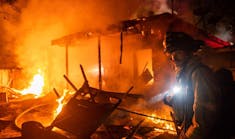People are being measured every day in a number of different ways, depending on a number of factors. Firefighters, officers and chiefs are measured as well, and how this is done also depends on several factors. When we are talking about fires, out-of-control events involving buildings, vehicles and wildland situations, the overriding factor that is often used to make the measurement is the results. Let’s face it, if the building burns down, we really can’t chalk it up to a win. I understand that a fire department could arrive at a serious house fire in the middle of the night and rescue the entire family and lose the house to the fire as well. Obviously, some of the results there are quite positive. But if every house fire ends the same way, with the house always burning down, is that good? I don’t think so.
Examples—with mixed results
So now let’s look at how we are measured relative to following the rules of our organizations. Could your fire department have a rule that prohibits officers from allowing civilians (or anyone who is not a member of the fire department) from riding on any fire apparatus? Sure! That’s a reasonable and understandable regulation. So one snowy and frigid evening, your company responds to a vehicle off the road, and when you arrive, there is, in fact, a minivan down in the ravine next to the highway. The firefighters climb down and investigate and discover a young mother and three children in the van. None of the passengers is injured, but they have been there for quite a while and they are all showing the effects of the cold. The ambulance will be delayed and the situation out on the shoulder is quite dangerous. The officer makes the decision to load the family into the apparatus and bring them back to the firehouse. Are we looking at a violation of the rules or a great officer thinking outside the box?
Well, unfortunately the answer may not be clear cut. As a matter of fact, the answer will depend greatly on the results. Let’s look at just two of the possibilities here. The fire apparatus makes its way back to the station with the crew and the family on board. The children begin to warm up inside the heated crew compartment and the mother begins to calm down. Good result! The chief back at quarters sees the family getting off the rig when the engine backs in and goes over to talk with the officer. He also sees that the family is not injured and that they have been removed from the dangerous roadside situation they were in and they are all safe. Great job! Great results! Great officer!
So on some other night, an officer and the crew from the same department respond to a similar situation involving a disabled vehicle. It is reported as a vehicle fire, but it is simply an overheated engine and the mom and her two kids are standing next to the vehicle on the side of the road. After the examination and securing the vehicle, the officer asks the woman if someone is coming out to pick them up. They are on a lonely stretch of highway about a mile from town and it is cold and dark. She answers no and that she may have to call a friend for a ride. The officer decides to load the family onto the apparatus for the short ride back to the warm firehouse. On the way back, the apparatus is involved in an accident and the two children and a firefighter are injured and taken to the hospital. When the company returns to the firehouse later, the chief discovers that there were civilians on the apparatus and that they were injured in the accident. Bad situation! Bad results! Bad officer!
Do the right thing
So you see, sometimes we do what we think is the “right thing” and we are praised. Other times we do what we think is the “right thing” and we are disciplined. When you climb into that front seat as an officer, you will be faced with many decisions. Always try to do what’s right and hope for good results! If you are not prepared for bad results, don’t ride in the front seat!

John J. Salka Jr. | Battalion Chief
JOHN J. SALKA JR., who is a Firehouse contributing editor, retired as a battalion chief with FDNY, serving as commander of the 18th battalion in the Bronx. Salka has instructed at several FDNY training programs, including the department’s Probationary Firefighters School, Captains Management Program and Battalion Chiefs Command Course. He conducts training programs at national and local conferences and has been recognized for his firefighter survival course, “Get Out Alive.” Salka co-authored the FDNY Engine Company Operations manual and wrote the book "First In, Last Out–Leadership Lessons From the New York Fire Department." He also operates Fire Command Training, which is a New York-based fire service training and consulting firm.






